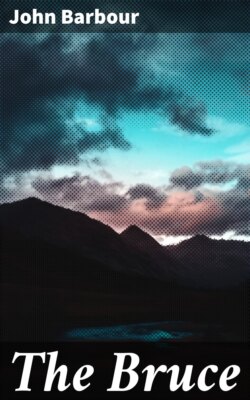Читать книгу The Bruce - Barbour John - Страница 6
На сайте Литреса книга снята с продажи.
3. The Present Edition.
ОглавлениеTable of Contents
The present edition of The Bruce is based upon the printed text of the Cambridge MS., collated throughout with that of E—that is, upon the versions of Skeat and Jamieson. I have, however, adopted rather more readings from E than does Skeat, also a few more from Wyntoun, and offer some slight emendations—e.g., luffys for liffys in Bk. II. 527, oft for off in III. 194, Fyn all for Fyngall in II. 69, etc. I have profited, too, by criticism of the published text as in the adoption of Dr. Neilson’s corn-but in Bk. II. 438. The question of Hart’s version has been discussed above; it is valid only as a check upon the MSS. Variants of any interest or importance are given in the footnotes.
There has been no modernization of the language save in the case of the rubrics, which are no part of the text proper and have been contributed by the scribes or editors in order to facilitate the understanding of the poem. I have thus adhered to the spirit while modifying the letter of their work. But while avoiding any change in the language of the poem or even any attempt at a uniform spelling, I have taken a few harmless liberties with its alphabet and restricted certain of the letters to their modern values, substituting for others a modern equivalent. Skeat did this in the matter of the ancient “thorn” letter = th. In consideration of the general reader, I have gone somewhat farther, viz.:
1 The s with the ornamental curl I read as merely s; Jamieson and Skeat take it as, generally, = ss. But such alternative forms as Parys,[22] purches,[23] and purpos,[24] on the one hand, and the actual use of the tailed letter following the ordinary type in dress, press,[25] fix the usage I have adopted.[26] There are a few exceptions in which this letter is probably a contraction for is—e.g., II. 366, 459.
2. I have distributed their modern values to i, j, u, v, w. There is no advantage in preserving such forms as iugis, Evrope, wndyr: the hedge of the language—to use Lowell’s simile—is prickly enough without these accessories. Moreover, I have throughout written Edward for Eduuard or Eduard and Inglis for Ynglis (C).
3. As Skeat has substituted “th” for the “thorn” (þ), I have done likewise with the ancient English g (ȝ), the “yok” letter, resolving it into the digraph yh. As ultimately, in almost every case, significant of the consonantal y, I might have simply replaced it by that letter. But alternative forms, nearly without exception, show the digraph, both in The Bruce and in Wyntoun, giving yhe, yhet, yharnit, fenyhe, etc., and in Wyntoun’s extracts feyhnnyng, senyhoury, yhystir-day, bayhllys, etc. Even with the original letter the h is added as often as not. Apparently the usage, which had practically disappeared from the southern practice, was in a transitional stage on its way to its full revival in later Scots, where it became fixed, at the hands of the printers, as z, and survives in such forms as Cadzow, capercailzie, etc.[27] In I. 16, however, it has been read as g in forget, though foryhet is to be found in Ratis Raving, and in XV. 75 it is obviously z in Fi(t)z-Waryne.
4. The placing of the capital letters and the punctuation are, of course, modern.
Further, the poem in MSS. is not divided into Books, but paragraphs are denoted by the insertion of a large capital; these, as in C, are similarly marked in the text. The division into twenty Books was first made by Pinkerton, and, as the most convenient, has been adopted by Skeat in his editions. From Pinkerton also Skeat adopts the numbering of the lines. Jamieson, however, made a division into fourteen Books with a numbering to suit. Cosmo Innes gave up the Books in favour of Cantos, with a fresh renumbering. To avoid confusion I have adhered to Skeat’s divisions and numbering, which are those of Pinkerton; inconvenient though the duplicate numbers certainly are, a totally new and fourth arrangement would be much more so. To break up and make more accessible the matter, I have also introduced, where possible, the paragraphs of Jamieson distinguished by spaces, some of these, however, being found in C. They are merely for the convenience of the reader. I may, perhaps, draw attention to the critical treatment of The Bruce as an historic document without which we move greatly in the dark. The historical notes of the early editors are few and superficial. Skeat does not profess to deal with the work strictly on this line (note, vol. ii., p. 224), though he does not fail to pass unnecessary censure at several places. But some such examination as I have tried to make seems necessary in the interests of Scottish historiography.
